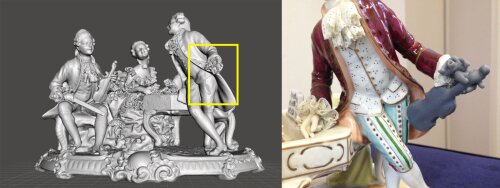Treating losses in cultural heritage objects with 3D scanning and 3D printing
Digital technologies - such as 3D scanning and 3D printing – are a gateway to a whole new world of applications for cultural heritage: Interactive displays in museums, virtual and augmented reality of heritage sites, replication valuable objects for tactile experiences, high resolution 3D models for research, simulation of lost polychrome decoration and monitoring, preservation and archiving of digital models are just a few examples.
3D technologies also allow searching for innovative ways to restore losses in complex or fragile objects. In similarity with the aforementioned examples, they also limit the handling of objects and thus reducing the risk of more damage as the reconstruction process, traditionally executed by moulding and casting or by sculpting directly on the object, can now be completed digitally in CAD-software.

Nevertheless, a new field of research implies knowledge shortcomings, as well as concerns about applying these novel methods and materials. Conservator-restorers active in the field have usually not received training to employ these novel technologies, and often do not have access to the fitting and costly equipment.
The ongoing fWO funded research project of Lien Acke on 3D technology (2019-2022) aims at making these technologies more available and comprehensible for the conservator-restorer. Based upon literature, practical experience and relevant case studies she seeks to provide a framework which can assist them in the process of loss compensation, by guiding them through the steps and possibilities.
Promotors: prof. Jouke Verlinden and Stijn Verwulgen (PO), Kristel De Vis (ARCHES)
Gel cleaning
Due to its irreversable nature, the cleaning of artwork surfaces is considered as one of the most important and critical actions undertaken by conservators-restorers. Cleaning processes include the removal of undesired deposits from the surface with the primary aim to improve or retain stability and, to a lesser extent, to meet aesthetical requirements. Lately, gels were introduced as carriers for cleaning agents as they allow a more controllable and selective cleaning . In the last two decades, conservation scientists developed numerous gels for this reason.
During his PhD research, Ehab Alemam, developed a double network hydrogel composed of polyvinyl alcohol-borax (PVA-B) and agarose (AG). The inclusion of agarose into the PVA-B system enhanced its properties, such as liquid phase retention, shape stability, and mechanical strength, in addition to being flexible and self-healable. It can be loaded with a wide range of cleaning agents, for instance, polar and non-polar solvents, chelators and surfactants. This new double network hydrogel overcomes some of the limitations posed by the individual PVA-B and AG hydrogels and thus it is suitable for a number of specific cleaning treatments including artworks with complex and/or porous surfaces, or when relatively long contact times are required on vertical surfaces, e.g. in the case of wall paintings. Moreover, it is convenient for cleaning actions in sites at elevated temperature and at low relative humidity levels.
The PVA-B/AG hydrogel was successfully used to remove deteriorated consolidant and soot layers from ancient Egyptian wall paintings from the temple of Seti I at Abydos and to remove an aged varnish layer from a nineteenth century wall painting in Antwerp – Belgium.
Promotors: prof. Joost Caen (ARCHES) and Prof. Koen Janssens (AXES)